This article needs additional citations for verification .(March 2009) |
Mulberry Island is located along the James River in the city of Newport News, Virginia, in southeastern Virginia at the confluence of the Warwick River on the Virginia Peninsula.
This article needs additional citations for verification .(March 2009) |
Mulberry Island is located along the James River in the city of Newport News, Virginia, in southeastern Virginia at the confluence of the Warwick River on the Virginia Peninsula.
Mulberry Island, settled shortly after Jamestown, was established a few miles downriver in 1607. It was at Mulberry Island where the colonists who were preparing to leave Virginia during the Starving Time in 1610 were met by Thomas West, 3rd Baron De La Warr with fresh provisions from England. By 1614, thousands of acres were under cultivation with tobacco, the export crop introduced by John Rolfe which saved the Virginia Colony financially. In 1619, Mulberry Island was part of the plantation held by William Pierce, Rolfe's father-in-law. [1] By the end of the century, Edward Digges owned a plantation on the island, and attempted to cultivate silkworms on the native mulberry trees.
During the American Civil War, Mulberry Island was the southern end of the Warwick Line, a series of defensive works built across the Virginia Peninsula to Yorktown manned by troops of Confederate General John B. Magruder during the Peninsula Campaign of 1862.
From 1898 to 1918, Mulberry Island was home to Davis & Kimpton Brickyard. [2] The brickyard sat on the west bank of the Warwick River. [3]
Prior to its acquisition by the U.S. government for $538,000, Mulberry Island was primarily farmland. During the first World War, Camp Abraham Eustis was established on the historic island and adjacent land in Warwick County, upstream from Newport News Shipbuilding and Drydock Company. Named for Abraham Eustis, a famous U.S. Army General from Petersburg, the camp had balloon observation school, and an artillery school that remained in operation through the end of World War II. Camp Eustis became Fort Eustis and a permanent Army base in 1923. In 2010, it was combined with nearby Langley Air Force Base to form Joint Base Langley–Eustis.

Fort Eustis is currently home to the United States Army Training and Doctrine Command (TRADOC). Since 1958, following a political consolidation of the former Warwick County with the independent city of Newport News, almost all of the base and all of Mulberry Island are located within the corporate limits of Newport News. An Army Aviation School is also located at Fort Eustis.
An array of ships part of the National Defense Reserve Fleet are anchored adjacent to Mulberry Island in the middle of the James River. Considered an environmental hazard, the numbers of this reserve fleet are being reduced each year as ships are transported away as scrap. These ships are termed the "Idle Fleet" in local parlance.
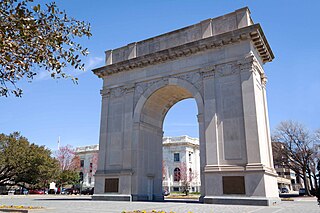
Newport News is an independent city in the Commonwealth of Virginia in the United States. At the 2020 census, the population was 186,247. Located in the Hampton Roads region, it is the fifth-most populous city in Virginia and 140th-most populous city in the United States.

James City County is a county located in the Commonwealth of Virginia. As of the 2020 census, the population was 78,254. Although politically separate from the county, the county seat is the adjacent independent city of Williamsburg.

The James River is a river in Virginia that begins in the Appalachian Mountains and flows 348 miles (560 km) to the Chesapeake Bay. The river length extends to 444 miles (715 km) if the Jackson River is included, the longer of its two headwaters. It is the longest river in Virginia. Jamestown and Williamsburg, Virginia's first colonial capitals, and Richmond, Virginia's current capital, lie on the James River.

The Virginia Peninsula is a peninsula in southeast Virginia, bounded by the York River, James River, Hampton Roads and Chesapeake Bay. It is sometimes known as the Lower Peninsula to distinguish it from two other peninsulas to the north, the Middle Peninsula and the Northern Neck.
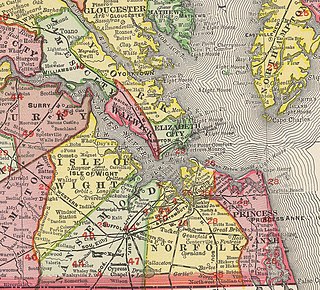
Warwick County was a county in Southeast Virginia that was created from Warwick River Shire, one of eight created in the Virginia Colony in 1634. It became the City of Newport News on July 16, 1952. Located on the Virginia Peninsula on the northern bank of the James River between Hampton Roads and Jamestown, the area consisted primarily of farms and small unincorporated villages until the arrival of the Peninsula Extension of the Chesapeake and Ohio Railway in 1881 and development led by industrialist Collis P. Huntington.

Fort Eustis is a United States Army installation in Newport News, Virginia. In 2010, it was combined with nearby Langley Air Force Base to form Joint Base Langley–Eustis.
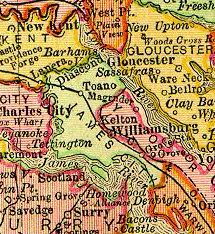
Grove is an unincorporated community in the southeastern portion of James City County in the Virginia Peninsula subregion of Virginia in the United States. It is located in the center of the Historic Triangle of Colonial Virginia, communities linked by the Colonial Parkway. This area is one of the busiest tourist destinations in the world.

Lee Hall is an unincorporated town located in the extreme western portion of the independent city of Newport News in the Commonwealth of Virginia in the United States.
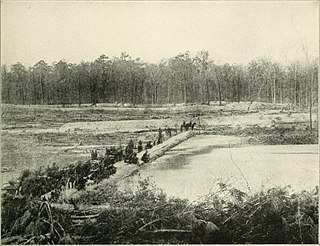
The Warwick River is a 14.4-mile-long (23.2 km) tidal estuary which empties into the James River a few miles from Hampton Roads at the southern end of Chesapeake Bay in southeast Virginia in the United States. Originating in York County near the northern side a few miles west of Yorktown, it flows south across the Virginia Peninsula and is almost entirely located in the independent city of Newport News.

Abraham Eustis was a lawyer and notable U.S. Army officer, eventually rising to become a Brevet Brigadier General. He saw service in Florida and became a notable artillery specialist and the first commander of Fort Monroe, located at the entrance to the harbor of Hampton Roads in Virginia.
The Warwick Line was a defensive works across the Virginia Peninsula maintained along the Warwick River by Confederate General John B. Magruder against much larger Union forces under General George B. McClellan during the American Civil War in 1861–62.
Camp Wallace was a facility of the United States Army located near the unincorporated town of Grove in southeastern James City County in the Virginia Peninsula portion of the Hampton Roads region of Virginia in the United States.

Skiffe's Creek is located in James City County and the independent city of Newport News in the Virginia Peninsula area of the Hampton Roads region of southeastern Virginia in the United States. It is a tributary of the James River.

Near the city's western end, a historic C&O railroad station, as well as American Civil War battle sites near historic Lee Hall along U.S. Route 60 and several 19th century plantations have all been protected. Many are located along the roads leading to Yorktown and Williamsburg, where many sites of the Historic Triangle are of both American Revolutionary War and Civil War significance. The first modern duel of ironclad warships, the Battle of Hampton Roads, took place not far off Newport News Point in 1862.

The Peninsula Extension which created the Peninsula Subdivision of the Chesapeake and Ohio Railway (C&O) was the new railroad line on the Virginia Peninsula from Richmond to southeastern Warwick County. Its principal purpose was to provide an important new pathway for coal mined in West Virginia to reach the harbor of Hampton Roads for coastal and export shipping on collier ships.

The history of Hampton Roads dates to 1607, when Jamestown was founded. Two wars have taken place in addition to many other historical events.
The Poquoson River is an 11.7-mile-long (18.8 km), mostly tidal river in the state of Virginia. The river is an estuarine inlet of the Chesapeake Bay, entering just south of the mouth of the York River.

The Matthew Jones House is a historic plantation house located on Fort Eustis in Newport News, Virginia. The house sits on a hill toward the northern end of Mulberry Island, overlooking the James River. It was built ca. 1725 as a one-and-a-half-story frame dwelling with brick chimneys and later underwent two major renovations. During the first renovation, in 1730, the walls were bricked in and a shed room and porch tower were added. During the second, in 1893, the house was raised to a full two stories. In 1918 the house and its surrounding land were acquired by the U.S. government for the establishment of an army post. By the late twentieth century, the Matthew Jones House had fallen into grave disrepair. In 1993 it was preserved and rehabilitated by the National Park Service in cooperation with the U.S. Army Corps of Engineers. Today it serves as an architectural museum.
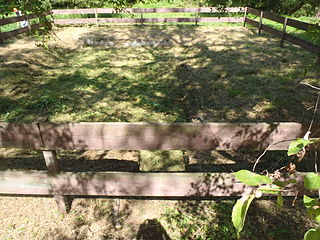
Fort Crafford is a historic archaeological site located at Fort Eustis, Newport News, Virginia. It is a pentagonal-shaped earthwork located on Mulberry Island and built by Confederate forces in 1862. The earthworks on Mulberry Island are considered part of the Warwick Line. The purpose of these works was to prevent the Union from flanking the line on the James River. The fort formed the James River terminus of the second trans-peninsula defensive line, which included fortifications at Lee's Mill, as well as Dam No.1 and Wynne's Mill in Newport News Park.
The following is a timeline of the history of the city of Newport News, Virginia, United States.